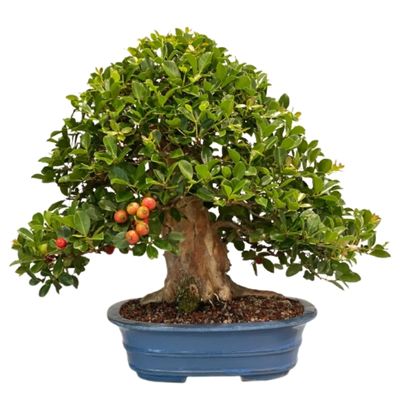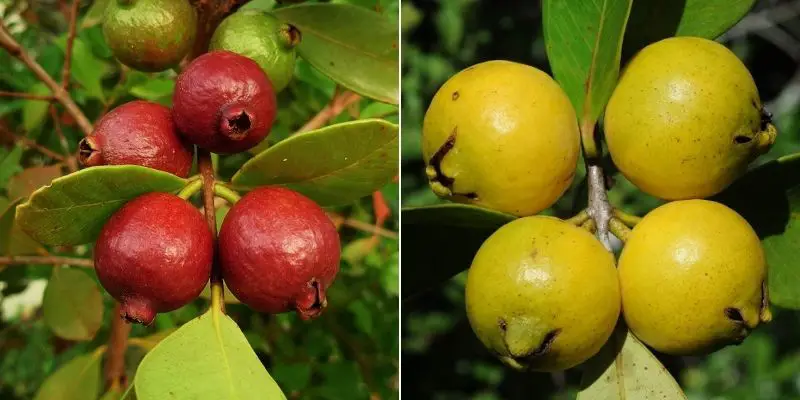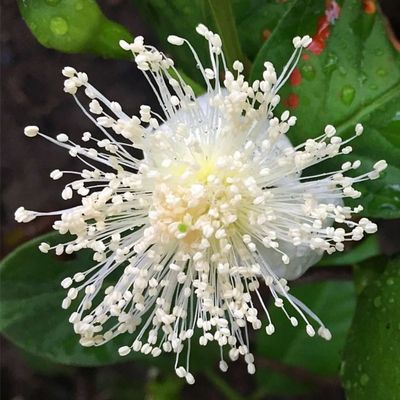
Cattley Guava / Strawberry Guava
(Psidium cattleianum / Psidium cattleyanum / Psidium littorale)
Country of Origin : Brazil
Bonsai Styles : Informal upright, wind-swept
Zone : 8 – 11
Cattley Guava (aka purple guava, red cattley guava, red strawberry guava and red cherry guava) is a tropical plant.
It has tiny, delicate and beautiful white flowers with multiple stamens that lead to the development of red fruits that are edible and beautiful to look at.
The bark of the tree is flacky, smooth and light brown in color.
There are large alternate oval leaves with a dark green color. It is a great species for midsize to large bonsai plants due to its large leaves.
A nice shade of red can be seen on the new spring growth.
The plant is capable of growing in a wide range of semi-moisture conditions. Additionally it also makes for a great indoor bonsai tree.
There is another variety of Psidium cattleyanum called Psidium cattleyanum var. littorale. The yellow-fruited variety is also known as yellow strawberry guava, yellow cattley guava, yellow cherry guava, and lemon guava.


Cattley Guava bonsai tree flower.
In mild climates, these trees bloom all year long. Spring is the best time for flowering, however.
Best location to keep Cattley Guava Bonsai
A well-lit environment is essential for the healthy growth of Cattley Guava bonsai.
Keep the bonsai container near a western-facing window with good sunlight if it will be grown indoors all year.
In the absence of good light exposure, use grow lights.
The tree should be grown at 80°F to 90°F (26°C and 32°C) from spring through summer.
To flower prolifically in late spring to early summer, the plant will require shorter days in fall and winter, at temperatures between 65°F and 70°F (18°C and 21°C).
This tree grows best outside during the late spring to early summer.
When nighttime temperatures drop below 68°F to 70°F (20°C and 21°C), bring it back inside.
Despite being able to tolerate cooler temperatures, it will acclimate to indoors more quickly if brought inside before the temperatures become too low.
IMP: Refer sunlight requirements for indoor plants for more indoor gardening ideas. Also, refer to do bonsai trees need sunlight for more indoor and outdoor bonsai location ideas.
Propagation of Cattley Guava
A host of propagation techniques such as stem cuttings, root cuttings, air layering, sowing seeds, grafting and even tissue culture can be used to propagate cattley guava.
However, seeds and root/stem cuttings are more common.
If using seeds, scrape the outer shell of the seed and keep the seed in water. Soak the seed in water for 24-48 hours. The seeds will swell (almost double their size).
Sow the seed. Keep the sowing medium in 70°F and 85°F (21°C and 29°C). Seed will take 1-2 months to germinate.
Sowing seeds is also done to take root cuttings to propagate multiple trees.
For growing the tree with cuttings, take 4-6 inches softwood cuttings. apply some rooting hormone and plant it in a pot. Keep the container at a temperature of 70°F and 85°F (21°C and 29°C). In 2-3 weeks, roots will emerge.
Watering Cattley Guava Bonsai
When grown in the ground, these trees can tolerate brief periods of drought. However, care must be taken when this plant is growing in containers.
Watering depends on the environment you are subjecting the plant to. One thumb rule you can follow is : Maintain a slight moisture level in the soil by watering as needed.
One more technique you can use is the immersion technique to water your strawberry guava bonsai.
Read watering bonsai tree for more details on immersion technique.
Wiring Cattley Guava Bonsai
You can wire this bonsai tree at any time of the year. However, wire when the shoots have become lignified. (semi-woody)
Pruning Cattley Guava Bonsai
When to prune Cattley Guava bonsai?
How to prune Cattley Guava bonsai?
Since Cattley guava has a relatively large leaf and fruit size, it looks best and stays healthiest if styled in an open shape.
To create compact but open growth that keeps the leaves from shading each other, prune the tree back to healthy shoots after fruiting in summer.
New buds will develop farther back on the branches.
The following spring, use these new shoots to create compact growth.
The Strawberry guava bonsai tree can tolerate heavy pruning. So if you are trying to develop a new bonsai tree from a tree lifter from the ground, don’t hesitate to give the tree a really heavy pruning.
However, you should keep the tree semi-shaded after this type of pruning. The tree won’t be able to cope with the stress if it is directly exposed to the sun. Give it some time to recover.
Repotting Cattley Guava Bonsai
When to repot Cattley Guava bonsai?
It is recommended that you repot this bonsai tree every two to three years. This also depends on how much pot bond the roots are.
Repotting is best done after fruiting, however you could also do it in spring before flowering if you prefer.
Strawberry guava is able to tolerate root pruning well, allowing you to remove 30 percent of the total mass of hair roots without any difficulty.
This species prefers slightly acidic soil.
You can use a basic free-draining acidic bonsai soil mix as a potting soil.
OR
Use a soil mix with sand, peat moss and loam at the ratio of 1:3:1.
Must Read: Bonsai Soil Recipes
Must read : Choosing the right bonsai container
Feeding Cattley Guava Bonsai
In the spring, you should fertilize your strawberry bonsai tree once a week with a fertilizer that is well balanced.
You should cease fertilizing just before flowering begins, and you should not fertilize again until the fruit has matured.
It is recommended that you fertilize once a month at half strength until spring when the growth slows down in winter.
You can also add some soil acidifier. Because these trees prefer soil with a pH of 5-7.
Read more about bonsai fertilizer and its application.
Diseases and pest of Cattley Guava Bonsai
It is possible for strawberry guava plants to catch algal leaf spot. One of the best ways to prevent this from happening is to ensure proper soil drainage, to hydrate the soil regularly.
Fruit flies and ants are some of the insects that attack the berries.
A layer of aquarium gravel or coarse sand on top of the potting soil is the best way to prevent fruit flies from laying their eggs.
By pruning a few branches on a regular basis, you will be able to control the infestation of black scales by increasing airflow and allowing more sunlight to reach the inner part of the tree.
You can control black scales manually or by spraying with a water jet. Or just prune the area which is infected. Also you can wash the tree with highly diluted soapy water and then rinsing with regular water as a preventive step.
In order to manage ants, you can set natural traps that are made from boric acid and sugar water. As a result of the solution, they will not be able to climb up the tree.
Cattley Guava bonsai care
Remember that this plant is a tropical plant and will require temperatures and climates resembling temperature of such region.
Hence, keeping the soil warm is necessary.
Although, the tree is pretty hardy ( can tolerate temperatures as low as 22°F (-5°C)), it is always a good idea to keep it in a warmer place when grown in container.

